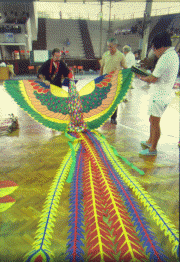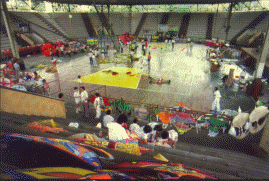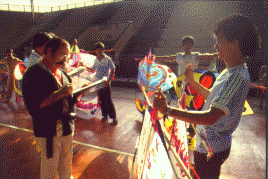


Updated : May 13, 2000
HISTORY
The Singapore Kite Association was registered in the Republic of Singapore in September 1982. Its founding members were Shakib Gunn, Tan Kim Hui and Tan Siak Yam.
The Association's symbol comprises two elements -- the Chinese character (ying) which means eagle or hawk and a red wau bulan. The Chinese character denotes our recognition of the origin of kite flying in China and its present day legacy in Singapore. The Malay wau bulan denotes our recognition of this kite as being indigenous to our region.
In history, kite flying can be traced back about 500 years. Sejarah Melayu (The Malay Annals) refers to the rule of Sultan Mahmud Shah of Malacca (a state of present day Malaysia) where he reigned from 1488 to 1511. In our rough translation, the annals say:
"It was the kite season when everyone, young and old, was flying kites of various kinds. One of the flyers was Raja Ahmad, eldest son of Sultan Mahmud whose kite was as large as a deer. While all the kites flying, Raja Ahmad launched his and because his line was thick, he cut down all the others, except for one. This belonged to Hang Isa Pantas whose kite remained aloft even though it was smaller than Raja Ahmad's. This was because his line had been coated in gum and powdered glass. Eventually Raja Ahmad's line was cut by Hang Isa Pantas and his kite drifted away towards Tanjong Jati."
Another and probably more accurate translation can be found in Mubin Sheppard’s Taman Indera, P.178.
This was during the 15th century, but it
has been reasoned that the Malays flew kites long before this. Wan Musa bin Jusoh in his Wau Malaysia a small booklet published in 1975 by Kementerian
Kebudayaan Belia dan Sokan, Malaysia (Ministry of Culture, Youth and Sports, Malaysia) and
long out of print, quotes from the Journal of the Institute of Anthropologist (sic), 'A
study in Polynesian Tradition' 1931, in which Nora K. Chadwick
suggests that kites were long used in the Malay archipelago to catch fish. There are, of
course, other references to kites being used by fishermen in the Malay-Polynesian
archipelago, a system used to this day.
In Singapore, at the tip of the Malaysian peninsular, there is a paucity of historic
references. Lee Kuan Yew, also the founder of modern day Singapore's
economic infrastructure, Goh Keng
Swee, are both on record as saying
they flew fighting kites in their childhood (1920s and 1930s), indeed there is hardly a
Singaporean over the age of 50 or 60 years who does not recall playing with fighting kites
is his kampong (village) during the monsoon period. (This tradition is carried on
today at places such as Marina South and an organization to promote the sport,
Kite-Fighting Enthusiasts Club, Singapore, was formed in I998).
The kitefighting tradition is possibly the
precursor of modern kite flying in Singapore. When the writer arrived in Singapore in the
mid-1950s, only fighting kites were to be seen. It seems probable that the pastime was
introduced by immigrants from China or India. Undoubtedly, Malays in Singapore were making
traditional wau bulan but when they came to the fore in the early 1980s they were
surprisingly modern versions of their Malaysian counterparts, using nylon rather than
paper for sails and graphics created from the imagination of the builder, rather than the
traditional pucok rebong (palm frond) and awan larat (leafy clouds). The
kites were much heavier and more durable too.
'Modern' kiteflying in Singapore
In the mid 1970s people were flying both home-made traditional Chinese kites such as the centipede (the Chua brothers being a good example) Chinese-made paper and silk kites bought locally, and kites from the west purchased on travels abroad. One popular area for flying was the newly reclaimed East Coast Park where a local Chinese newspaper, Sin Chew Jit Poh, sponsored a demonstration by a centipede kite flyer from Taiwan in 1976 or 1977. Following this, the newspaper organized Singapore's first kite competition ‘National Kite Design & Flying Competition’ on 16 September 1978, the guest of honor being the general manager of Neptune Orient Lines, Goh Chok Tong, now Prime Minister of Singapore. In August 1996, some 18 years later, the Singapore Kite Association was part of a 'Family Fitness Festival' at which Shakib Gunn showed Goh Chok Tong a photograph of them at the 1978 festival. "Yes, I remember!" said PM Goh, reconfirming the believe that kites somehow have a special quality, of being remembered and creating links.
In 1981 Singapore Tourist Promotion Board announced the intention to hold a kite festival in Singapore. Shakib called them and discovered that they lacked basic information about timing, site, organization, judging, contacts etc, but they had at their disposal a huge organisational structure, and money.
Singapore International Kite Festivals 1982 -- 1986
- Five major festivals
- Computerised results on the field
- A system for judging
- What we learned
Five major festivals
An organizing committee was set up comprising Singapore Tourist Promotion Board (promoter, secretariat, hospitality, food, accommodation, transport), People's Association (field infrastructure -- tents, stands for public seating etc), Sin Chew Jit Poh (field helpers, marshals, scorekeepers), Singapore Armed Forces (anchorage trucks, helpers for large kites), the Police (crowd control, parking logistics) and Singapore Kite Association (program of field events, judging, announcing) . The key organizers at the Singapore Tourist Promotion Board were Joseph Kong (chairman of the committee), and Sharon Wong, a senior marketing officer who was to underpin the success of the festival in the ensuing years. Budget for the first festival was S$125,000, rising to over S$200,000 for later festivals, much of this going to site development and hospitality for overseas guests. The concept was to combine two events -- a kite-making and kite-flying competition for local entrants and a 1½ day spectacle for the public. Almost 200 kites were entered for the competitions categorized under Oriental, Wau, and Western.
It was argued that to get Singaporeans
building for the competition, considerable prize money would have to be put up and budgets
ranging between S$20,000 and $27,000 were the norm. These catered for the three
categories, different age groups with, in one year, donations for the winners' schools.
1982 -- held at West Coast
Park. Overseas flyers included Taiwan (a team led by Chang Giunn), Japan (a team led
by Masaaki Modegi, including 80 year old Katsuhisa Ohta and Fusaji Anzai, a team from India with fighting kites, Daud bin Mamat and Yusof bin Abdul Majid from Malaysia.
1983 -- held at West Coast
Park. This guest list was expanded
and the centre of attraction was the world's largest kite from Holland.
Michele de Vries of the Dutch team spent much time with Singapore Kite Association
pre-planning arrangements for this expanded venture. Their leader was Gerard van der Loo
then described as a "34 year old photographer turned antique dealer", supported
by Bert van Nierop, Nop Michele Velthuizen, B Kramer, B van Roon, W Stam, Mvan Dullemen,
Nick Morse, B Hoogerdijk, Cvan Hengel and I Thepas. Other countries represented included Australia (Peter Travis), Korea (a team led by Roe You Sang), Thailand Prinya Sukchid (otherwise known as Superman and his crazy gang), United Kingdom (Jilly Pelham, Mike Pawlow, R M Goodman and the Greens of Burnley)
and Hong Kong. We also welcomed again Japan
(Modegi and new faces, including for the first time, Satoshi Hashimoto), Taiwan (Chang
Giunn and team), and Malaysia (Noor bin Mat Hashim and Mukhtar bin Yusof). We
also received a surprise visit from flyers from Persatuan Penggemar Layang Layang Jakarta Raya ( Perlajaya) , a six member team bringing with them 1 meter tall
fighting kites flown from geared winches fixed to wooden trestles. We have not since met
this group and wish to record their names for posterity -- Hadi Halim, Rahardja Halim,
Rachmat Rayat, R.M. Muchtar, Eddy Santoso and Saiful Anwar.
1984 -- held at West Coast Park. An expanded guest list included a return of the Dutch team (still led by Gerard van der Loo and still billed as 34 years of age), now flying the red-sail 7m x 7m 'Flying Dutchman'. We also saw for the first time, Nop Velthuizen's genki or ultralite, a marque which was to become popular in the light winds of Singapore. Others included Australia (Peter Travis), Japan (a team from Shirone led by Jinzaburo Hokura), Taiwan (this time a team led by Kin Kan Hsieh), Malaysia (Kasim b Haji Abd Jabar, Tajil Arus b Abdullah, Abd Rahman b Abdullah, Mukhtar b Yusof and Kamariab bte Awang Mamat), Thailand (Superman and gang, including his 88 year old father, Kert Sukhchit). UK (the Halls), and for the first time, New Zealand (Peter Lynn and Clyde Cook presenting the Tri-D and who was rightly quoted as saying, "the most dramatic and demanding kite activity is the flying display where it is necessary to put on an interesting and attention – getting show irrespective of weather and often at pre-arranged time regardless of wind strenghth. Doing such a show requires more than superficial kiteflying skills"), USA (Tal Streeter, the Burkhardts and Tom Van Sant), flyers from Bali led by Drs I Gusti Ngurah Rai Girigunadhi , then director of Dinas Pariwisata (Badung Tourist Promotion Board). It was gratifying to be able to introduce two heads of different tourist boards to each other, Mr Tan I Tong, Chairman, Singapore Tourist Promotion Board and Drs Rai, his counterpart in Bali. Both agreed that had it not been for the kite festival, they would have never met.
1985 -- Marina South, a vast tract of land south of the central business district was being developed and it was thought to be ideal for a festival. It lay in the path of the northeast monsoon, and there was ample space for parking. Considerable effort and money was invested in site development and it was to host the festival for another two years. Chairman of the Singapore Tourist Promotion Board wanted to see an extended festival, thus local preliminaries started some three weeks before the main event. Design judging for local kites was held one week before the final in the Gay World Stadium, which became an event in itself. The festival was now becoming big and ease of access for the public was a vital consideration. New faces included Doug Hagaman, Dave Checkley, Pete Hoover and Robert Loera from USA (amongst many other friends), and David Chandler and Don Sutherland from Tasmania. Peter Lynn was again at the festival and went on record saying "Never in my professional life have I been cut down so many times". The culprits being our wau bulan which left unattended will clear a whole field of kites. Peter reported being cut down 16 times and Singapore Kite Association had to form a mobile recovery unit headed by Eric Ang.
1986 -- Marina South. This was to be the last festival sponsored by Singapore Tourist Promotion Board. Following the 1986 festival they turned to power boat racing as they felt crowd attendance would be more predictable. This year we again welcomed Australia (Leon and and Moira Pericles and a whole gang of family supporters, about 13 of them, for the first time), Japan (The Japan Yohkaichi Odaka Preservation Society led by Kyuji Nishizawa) also Modegi with Japan Kite Association team including Hashimoto and Tsutsumi, Malaysia (new faces including Abd. Rahman b Saad and Mohmmad b Yusof), Holland, New Zealand (including James and Judy White), USA (Robert and Barbara Loera, Tom Casselman and Herbert (Pete) Hoover), United Kingdom (Martin Lester and Mike Pawlow), and newcomers Canada, Germany (The newly-wed Shimmelpfennigs), France (The Blatrys and Michael Gressier), Italy (a team led by Olivero Oliveri). During this period, and in the years to follow, a lot of organizational planning was done by Singapore Kite Association's Michael Seet to whom the association owes a debt of gratitude. Other flyers who consistently supported us included Robert Foong, Ng Thang Eng, Eric Ang, Loh Chin Nghee and the Chua brothers.
Computerised results on the field
After the 1989 festival only 'SKA
Flying days ' have been held, all in February, during the cessation of the Northeast
monsoon. An innovative feature (at least at that time) of the 1985 festival was the
introduction of on-field computerized competition results, made possible by SKA member, Steve Safter, an American then living
in Singapore. This reduced the number of people needed to hand crunch and weigh raw
numbers. It looked very impressive and the results were 'unquestionable' but latterly we
decided that the effort did not justify the benefits and when Steve returned we went back
to the hand calculator and spread sheets.
A system for judging
|
 |
 |
One by-product of the festivals was the creation of a system for judging competitions. With three categories of kites and with judging both on the ground and in the air, plus many participants all hungry for cash prizes, we needed a system that was transparent and reasonably fair. The panels of judges comprised a mix of foreign and local flyers with the chief judge being included in all panels. Three categories of kites with design judging (on the ground) and performance judging (in the air), plus two different age groups resulted in the need for 12 panels. The chief judge rotated judges depending upon their stamina; for example design judging 60 wau bulan for the flying competition could take two hours or so of standing in the hot sun. To speed up performance judging, contestants were called up to fly in batches of six. The length of time required for design judging, the fact that it holds little spectator appeal, and the physical demands upon the judges, led it to being held one year in an auditorium. When performance flying was not held on the same day as design jjudging, kites were marked with an indelible signature to prevent switching.
Points were awarded, 50 for
design and 50 for performance, with both design and performance being sub-divided with
slightly different criteria for the three categories of kites, for example whereas
Oriental and Western categories rated stability as worth 10 points this did not apply to
the Wau category where elliptical movement and sound of the hummer scored points.
Points awarded were in the range 20,15,10 and 5, but judges were required to score on a scale of 1-10, half points included, and their scores were weighted accordingly.
Performance judging always took place
during periods of strong wind, leaving design jjudging for the lulls in the weather --thus
flexible scheduling was important. Judges paraded around the kites prior to judging and
this led to useful discussion and enabled them to get a feel of the situation before
judging began. Scoresheets included space for a brief description of the kite and this
proved useful in the event that identification was necessary. After totaling each category
and age group, the judges were recalled to discuss any abnormalities in the scores and to
ratify results.
What we learned
The most important things we learned about
kite festival organization was the importance of the very FIRST step and the very LAST
step. The very first step is to know your OBJECTIVE. The very last is to hold a POST MORTEM after the event.
A clearly defined objective seemed
important, for without this, there would be no equitable way of assessing the success of
the festival. With the Singapore international kite festivals, we had a range of possible options – to provide visual material for the Tourist
Board's promotion of Singapore as a City of Festivals, to attract more tourists to
Singapore, to provide Singaporeans with an outdoor spectacle, to provide schools with an
extra curricular activity/window on art opportunity, to help promote kite flying as a
healthy pastime, to gain global exposure for Singapore through the media and so on. In the
event, objectives were not clearly defined and thus it was difficult to make a fair
determination as to the success of the festivals. The last step, the Post Mortem, usually
covered 15 or more headings and was held within one week of the closure of the festival.
This document was invariably the first to be read and digested prior to future planning
meetings.
Other considerations, often too easily
overlooked, concern timing and site selection.
Timing involved study of the seasons, weather patterns and school holidays. In Singapore,
the month with the most and strongest wind is January, yet this is in the middle of the
Northeast monsoon and January is the wettest month. The site nearly always needs to be
bigger than you visualize, ideally on a perfect axis to the prevailing wind, with a good
surface and drainage, easy access for the public and with adequate parking space.
With clear objectives, the right dates and a good site, you may start on the organization!
With the Singapore festivals that were expected to large good crowds, we found lots of sustained publicity to be essential, starting several weeks before the event. If
competitions were involved, we needed to give ample time for registration and kite
building. At least ten days of publicity prior to the event (press, TV, radio, posters for
hotels etc) was required to move the crowds. The weekend before the festival, there were
newsworthy press conference-cum-demonstrations and separate interviews with quoteworthy
personalities. All tourist magazines, events columns in newspapers etc were covered weeks
in advance. The presence of international media is important if global publicity is
sought.